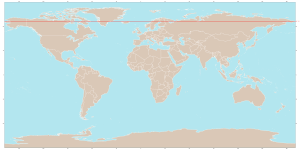Arctic Circle facts for kids
The Arctic Circle is a special imaginary line around the top of our planet, Earth. It's one of five main circles of latitude that you often see on maps. This line is found at about 66° 33' 39" north of the Equator.
Think of the Arctic Circle as the boundary for the Arctic region. The North Pole is right in the middle of this circle.
Contents
Countries in the Arctic Circle
Many countries have land that reaches into the Arctic Circle. These include:
- Russia
- Canada
- Denmark (through its territory, Greenland)
- United States of America (through Alaska)
- Norway
- Sweden
- Finland
- Iceland (a very small part, less than 1 square kilometre)
Why the Arctic Circle Moves
The exact spot of the Arctic Circle is not always the same. It slowly changes over time! This is because of something called the axial tilt of the Earth.
Earth's Tilt
The Earth doesn't spin perfectly straight up and down. It's actually tilted a little bit. This tilt is what gives us our Seasons. The amount of this tilt changes slightly over thousands of years.
How the Tilt Affects the Circle
Because the Earth's tilt changes, the Arctic Circle also moves. It can shift by about 2 degrees over a very long time, around 40,000 years. This movement is mostly due to the pull of the Moon's gravity. Right now, the Earth's tilt is getting smaller. This means the Arctic Circle is slowly moving northwards. It shifts about 15 meters (or 49 feet) every year!
Related pages
- Northern Hemisphere
- Southern Hemisphere
- Eastern Hemisphere
- Western Hemisphere
- Seasons
- Solstice and equinox
- Equator
- Tropic of Cancer
- Tropic of Capricorn
- Antarctic Circle
- Circle of latitude
Images for kids
-
At night, bright aurora borealis are a common sight in the Arctic Circle. This picture shows the northern lights in Rovaniemi, Finland.
-
The Arctic Circle line in Rovaniemi, Finland, around 1865.
-
A sign marking the Arctic Circle's location along the Dalton Highway in Alaska.
-
Aurora Borealis above an Arctic Circle sign along the Dempster Highway in Yukon.
-
The white borderline of the Arctic Circle at the Santa Claus Village in Rovaniemi, Finland.
-
A sign in the Sakha Republic (Yakutia), Russia.
See also
 In Spanish: Círculo polar ártico para niños
In Spanish: Círculo polar ártico para niños














